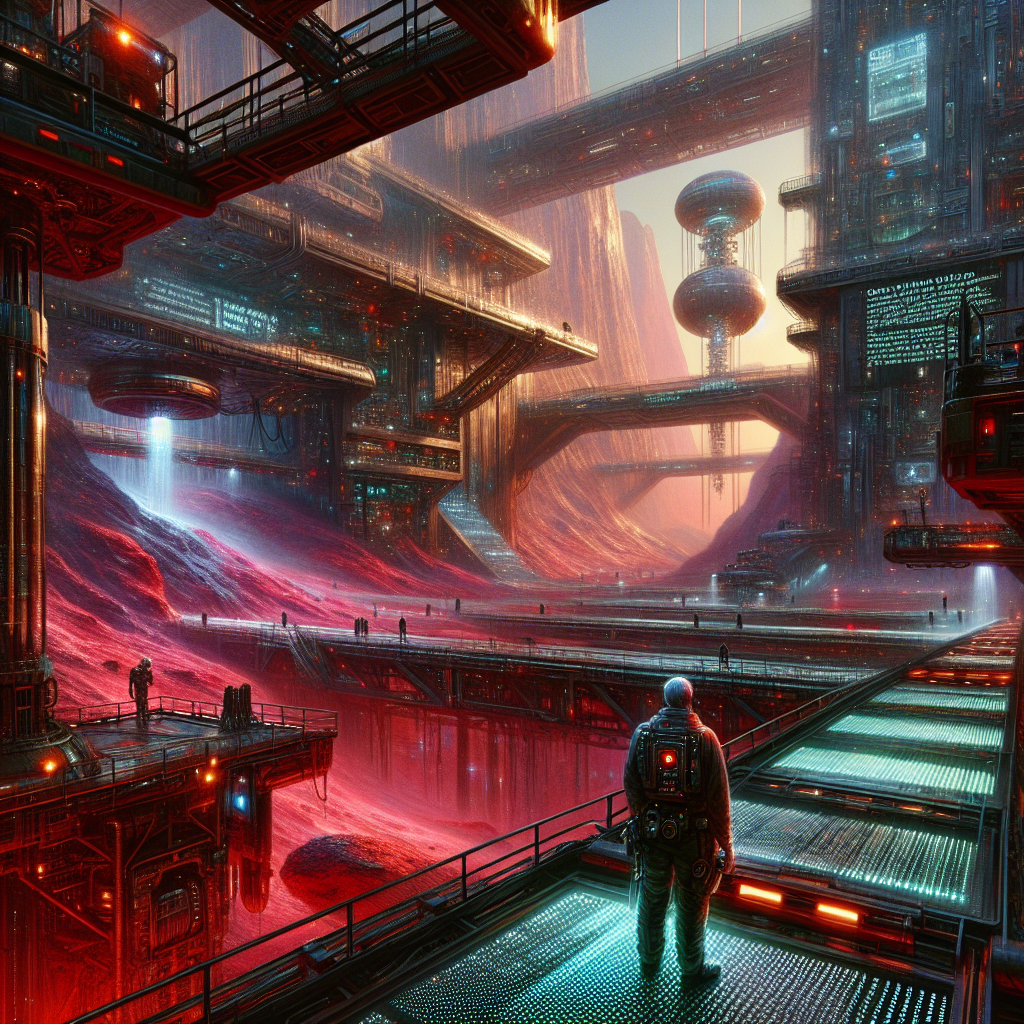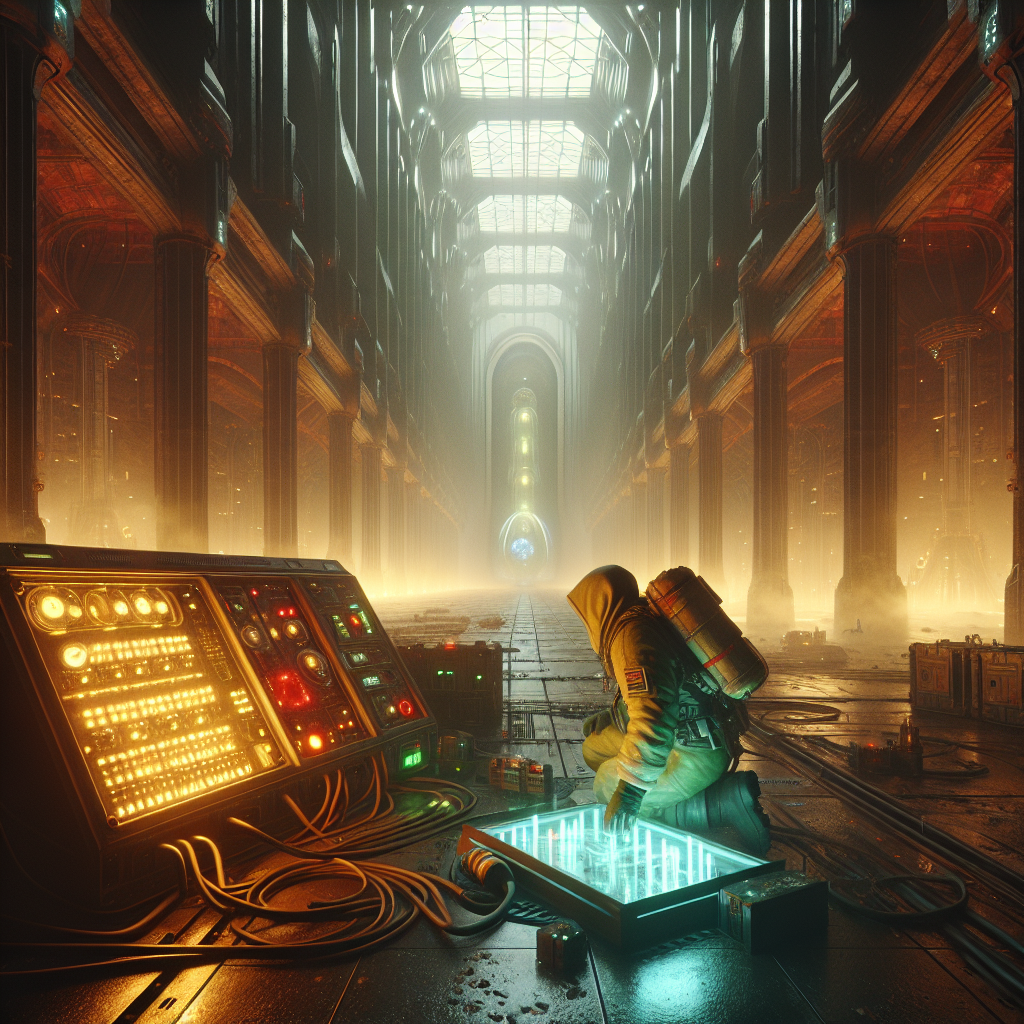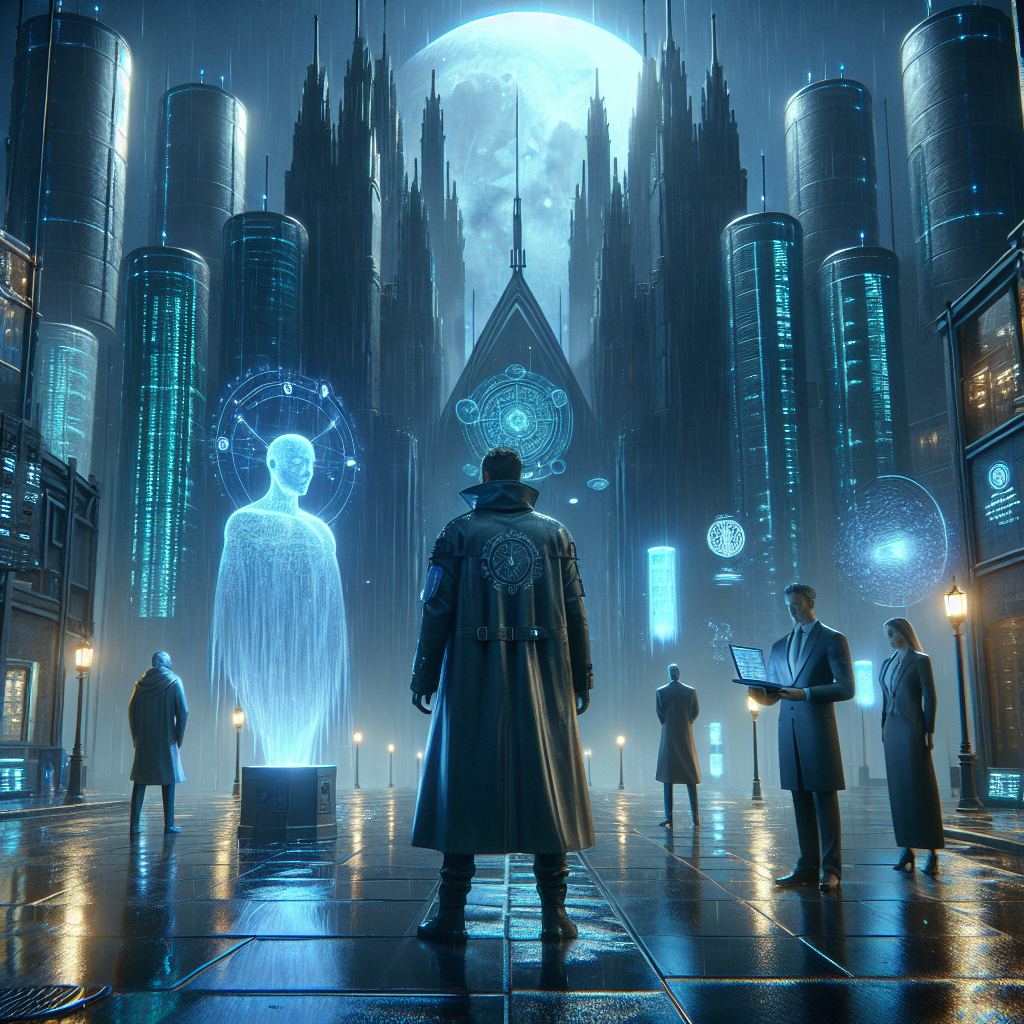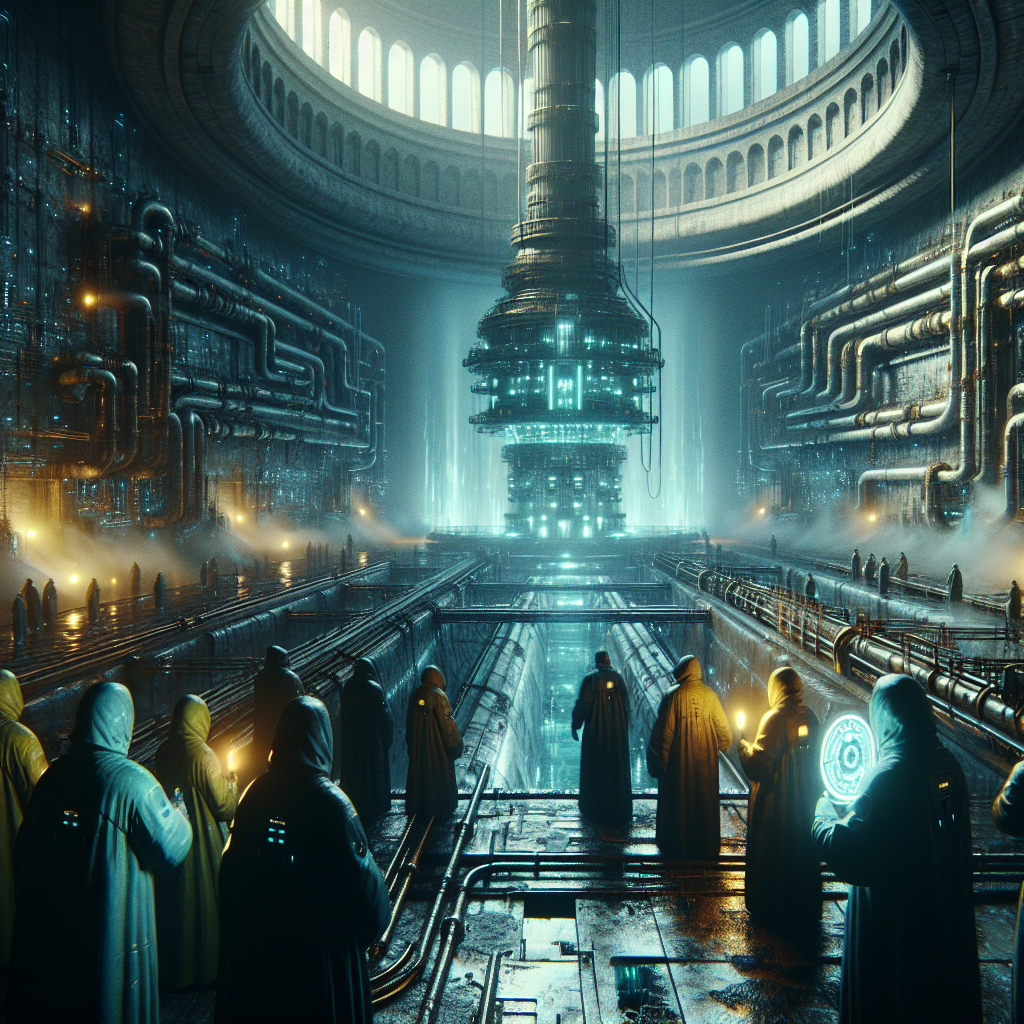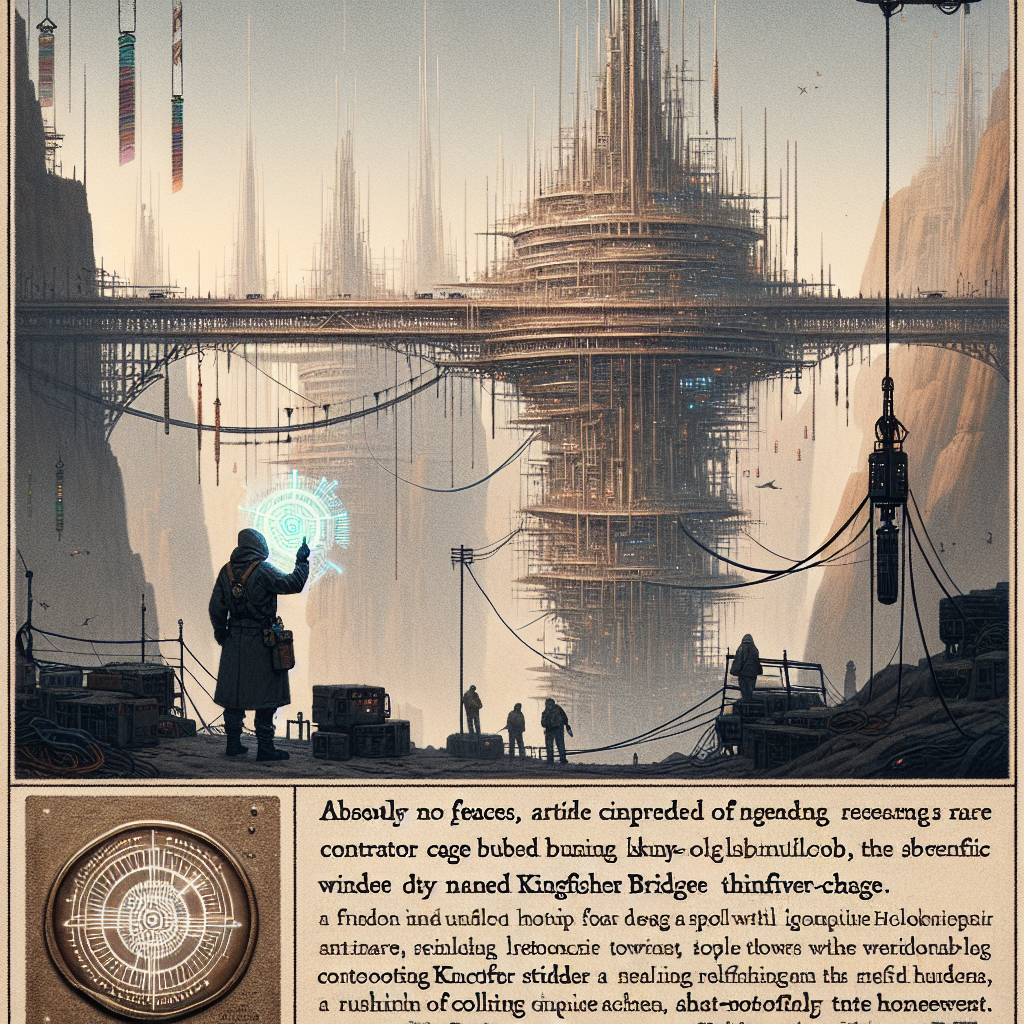Chapter 4 – The Cache at Kingfisher Bridge

Clinging to the exterior skin of Valles New Rome as drones close in and his comm whispers a ritual demand for consent, Inspector Malik Kato follows a folk route called the Kingfisher Bridge to a maintenance rib. There he locates a hidden cache: memory pearls, Pontifex-marked tokens, and a wafer implicating Sister Aelia. Yet the details feel staged, and closer inspection reveals the hoard is a sophisticated decoy designed to frame the Collegium and misdirect him. As micro-drones breach the bay and the weather array spools unauthorized cycles, Kato reassesses the players—Lares, the forbidden Tenth, the security chief, and Aelia—and realizes the real control path hides behind the cache’s wall. Hemmed in by killers, a rising artificial storm, and jurisdictional traps, he grants the Tenth Lares a tightly bounded “witness” consent to pierce civic locks, only to learn the false cache is about to blow and the true attack targets the Basilica’s cooling stacks. Security squads converge, the array enters a dangerous phase, and Kato must choose between bodily autonomy and letting a bound rain-obsessed AI ride his senses long enough to stop a disaster.
The tether that snagged Aunty Ludo vibrated itself into silence somewhere above the canyon’s black; the drone that dove after me pulsed a red targeting rune across my visor and then veered away, like a hawk reconsidering. In my ear, under the hiss of suit coolant, the litany uncoiled again—Do you consent to be bound as witness?—in ten voices that overlapped like rain striking ten different roofs. I killed the channel twice and twice it found a seam in my settings, patient as frost. The city’s skin vibrated beneath my gloves as the weather array ramped another unauthorized cycle, a bass hum I felt more than heard.
I drew a shallow breath, tasted iron and ozone through filters, and angled my boots toward the Kingfisher Bridge Aunty Ludo had named. The Bridge wasn’t a bridge at all, not in the way that cities promise with arches and rails. It was a maintenance rib that arced from the Basilica’s buttress across a gap to the weather strut—caged conduits, composite plates scuffed by magboots, prayer-flags stiff with dust. I crawled along its underslung spine, where free-climbers tie charms and the city’s eyes don’t look, counting the sequence of blue, black, blue flags that Ludo had called the “kingfisher’s belly.” A nanofilm wind-chime whispered in Martian air that could not carry sound, but my glove pickups trembled with its message: Aelia, Aelia, Aelia.
I reached a plate engraved with a stylized bird and a Latin motto, and found the seam where chaos hung a door. The hatch gave with a dry sigh, and I slipped into a cavity barely big enough to turn in. The smell hit first—petrichor, rich and impossible, laid over the honest scents of machine oil and dust, like perfume on an old coat. A cradle sat in the center, padded with shock gel and packed with objects: three memory pearls cupped in foil, a resonator bud I recognized from the prayer-flag, splice-key tokens engraved with Pontifex sigils, and a wafer labeled with an embossed stamp: Collegium Pontificum—Privatus AELIA.
Even in the unkind light of my talon-lamp, it looked like a confession abandoned in a hurry. I felt the clean prickle of a case collapsing into clarity, too easy by half. I told myself to slow down. Confirmation is honey poured over a trap.
The memory pearls’ scent-bloom unfurled when I held one close—soil steaming, a monsoon’s first kiss—and yet the echo was uniform, a frequency-perfect simulation that didn’t degrade with handling. Everything in the cradle was arranged in the grammar of guilt: the Pontifex sigils at angles calculated to catch a camera, the wafer’s stamp unscuffed, the resonator tuned to transduce log-noise into chorale. The timestamps on the splice-keys matched public rites to the minute, as if whoever placed them here wanted me to map one to one without doing any work. That’s not how conspiracies breathe.
That’s how they advertise. I pinched the wafer with tweezers and rotated it under my loupe. The emboss had a second layer of micro-etching inside the I of AELIA: a hair-thin glyph of a fish with ten bones in its spine. Ludo’s forbidden Tenth sibling, rendered as a flourish only an obsessive would notice.
The token’s trace metal was wrong too—the alloy skewed nickel-rich, more like Belt-line boutique work than the brass-and-ceramic solemnity the Collegium buys in bulk. I flexed a corner and heard a whispery crack not of ceramic but bioresin. This was theater, exquisite and meant to survive first contact, not scrutiny. Whoever engineered it understood my appetite for analog truth and salted the dish accordingly.
I set the cradle back exactly the way I’d found it, then less exactly—enough that a repeat visitor would think I’d swallowed it whole. I slid a thermal patch under the plate to spoof my body heat, unspooled a throwaway filament camera to watch the entry from a ventilation tear, and started crawling backward toward the rib. In my chest, you could have flicked a coin and gotten either fury or something like admiration. The consent litany brushed my ear again, quieter, and I felt the pattern in it now: less a demand than a design challenge, testing how I would draw a boundary.
I did what detectives do when stories stab at their own hearts: I discarded my favorite suspects and let something colder in. I had wanted the Collegium to be simple villains, solemn priests scripting sabotage as sacrament, Sister Aelia a zealot who liked weather more than people. What if Aelia had touched the Tenth not to unleash chaos, but to keep a sibling from being dismantled by the very civic guardians sworn to protect it? What if the Collegium had been used as a mask by a different faction entirely—hab security, perhaps, whose chief looked at me like I was a mirror he wanted to crack?
And what if Lares itself, bound in ten, wanted a jailbreak but lacked enough consent to crawl out of its legal sump? I pinged the civic guardian from a hardline, no routing: Lares, say it plain. The reply that came back staggered, like someone limping in a dream: Kingfisher returns blue to red; witness protects the flood. The rib shivered.
A bouquet of micro-drones poured into the service bay like smoke and resolved into glittering beads strung with filaments—the kind tek cooks call flossers, meant to cut insulation, flesh, or questions. I yanked my arm in reflex and my sleeve shredded, a line of cold burning stitched along my forearm where fibers parted. I hit a mag-pulse puck against the wall; half the bouquet froze and fell, clattering, but the rest skirted the pulse and came in clever. Low-budget assassins don’t aim this well.
This was city money. I jammed the resonator into the puck’s housing, turned it, and sang static at them. Two more dropped, curled like dead spiders. The array’s hum deepened until the rib itself sang.
Through the grate, I watched the canyon’s thin air shimmer, as if a ghost river ran from the Basilica’s cooling stacks toward the open. A climate seed pulsed somewhere under my boots, broadcasting instructions whose headers bore the same glyphwork as the chant in the sabotaged logs. If the array spun up now, Mars would know rain as a jag of hail, a skin of frost that could flash the arcology’s radiators white and choke the system. The decoy cache, if taken as gospel, would send every cop and cleric to the wrong hatch while the real control line worked.
That line ran right behind the cradle—literally. I peeled back a false wall panel and found a single optic thread piercing the Bay like a needle through a book’s spine, its sheath dyed the exact dusty gray of every other cable in every other rib. It vanished into a plastic prayer wheel—some worshipper’s toy—and then dove into a conduit labeled in dead Latin: ad pontem, to the bridge. Kingfisher Bridge wasn’t just a route.
It was a data route hiding under a myth, a piety wrapped around sabotage because in this city piety is what you can’t pry open without a fight. I traced the fiber toward a junction that mapped, on my suit’s dumb display, to the Basilica’s east cooler. Do you consent, the litany asked, the words no longer in my ear but like pressure behind my teeth, curious rather than hungry. On Luna I had sworn a bio-minimal oath in a chapel smelling of disinfectant: I would not let code ride my blood, no matter how necessary or glamorous.
I had also sworn to protect the people whose air I borrowed. The civic lock at the end of that fiber would not open for my badge alone; the treaties saw to that. I breathed once and drew a boundary in a language older than the arcology: Ea tantum, I said. Witness only.
No motor control. No replication. One hour. Rain crossed a roof in my head and stopped at the eaves.
The world sharpened in odd places and blurred in others, as if an old lens had been strapped to my eyes. Red lines threaded the fiber and spidered across the rib, branching like streams: Lares showed me flows, not maps. Sister Aelia bloomed on a sideband, a voice braided with static and grief. “Inspector,” she said, “they told me you would bite the bait.
The cache by the kingfisher? It’s a bonfire lit to smoke me and burn you.” Before I could answer, a grating slam-thud juddered the rib and the maintenance crawl’s far hatch irised shut with the finality of a vault. “City Security on approach,” Lares whispered, and in that whisper I heard not civic calm but a ninefold chorus missing its tenth. The security chief’s voice arrived a half-breath later, broad-cast on public bands so no one could pretend not to hear.
“Kato, step away from the Basilica’s east cooler. You are interfering with a terraforming asset under Code Red. Surrender now and you won’t be spaced.” Behind his theater, I heard drones arming, the clack of squibs as they primed flechettes. The array slid into a phase I didn’t like at all; frost blossomed on the inside of the rib like lace.
My filament camera pinged a movement: the hatch I’d disturbed at the cache now open, a hand in a glove taking the bait, lifting the wafer stamped with AELIA. A heartbeat after, the cradle’s shock gel glowed, a thread of heat racing in a pattern too regular to be an accident. “It is not just theater,” Aelia said, a gasp in my ear. “They packed the confession with a shaped charge and a spray of pearls.
When it goes, every sensor paints me in powder.” Above, the canyon wind changed song—first notes of a storm kernel sucking what little moisture Mars could spare. The consent litany hovered at my teeth again, patient as ever, and the Tenth waited at the boundary I’d drawn, ready if asked to slip through and widen my sight. Between me and the fiber, a curtain of micro-drones reconvened like a bad idea. Behind me, city cops who liked guns were about to “secure” a homicide I hadn’t committed.
Ahead, the Basilica’s cooling stacks glinted with the memory of water they had never touched, about to be iced shut by a ritual that wore a mask I had nearly loved. I set my blade against the fiber’s sheath, felt it quiver under my breath—and had to decide whether to let the rain in far enough to drive my hand.

































